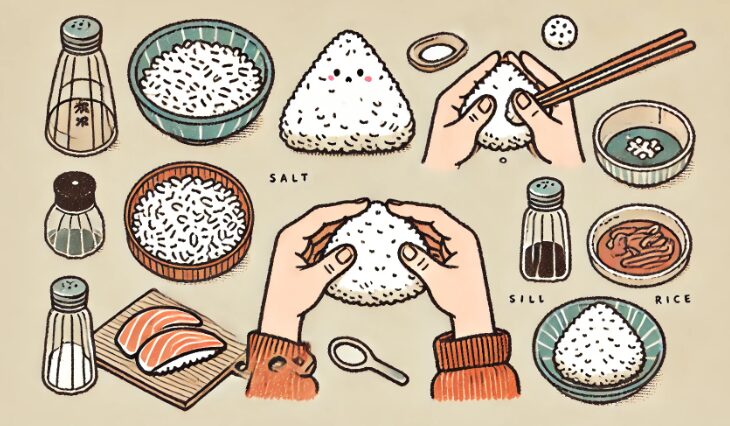The Basics of Making Onigiri: A Professional’s Guide to Cooling Rice and Preparing Nori

Making onigiri is a staple in Japanese home cooking, and mastering the basics can elevate your onigiri to the next level. In this section, we’ll dive into the expert tips on how to properly cool rice and prepare nori for onigiri. We’ll especially focus on the importance of cooling the rice when you plan to eat it later, and how to bring out the rich flavor of even the most affordable nori from the supermarket.
The Importance of Cooling Rice
When making onigiri, it’s common to use freshly cooked, steaming hot rice. However, if you’re planning to eat the onigiri later, there’s an important step you shouldn’t skip: cooling the rice. If you mold onigiri with hot rice and wrap it immediately, the trapped steam can cause the rice to become mushy, and it may lead to bacterial growth, increasing the risk of food poisoning. This is why professional chefs emphasize the need to let the rice cool slightly before forming the onigiri.
To cool the rice, spread it out after cooking to let the steam escape and wait until the temperature drops a bit. This helps to keep the rice from becoming too sticky and ensures that the onigiri maintains a light and fluffy texture even after it’s been stored. Cooling the rice also improves its shelf life, allowing the onigiri to stay fresh for longer.
Choosing and Cutting Nori
Nori is an essential part of onigiri, and there are some tips for selecting and handling it. Even if you’re using inexpensive nori from the supermarket, a few simple techniques can enhance its aroma and texture.
First, it’s important to recognize the difference between the front and back sides of the nori. The front side is smooth and shiny, while the back side has a rougher texture. Understanding this helps ensure that the nori adheres well to the rice and doesn’t peel off easily when wrapping.
When cutting nori, follow the natural vertical lines that run through the sheet. Cutting along these lines makes the nori easier to handle and gives a neater appearance when wrapping the onigiri.
Enhancing Flavor by Toasting Nori
A popular technique among professionals to enhance the flavor of inexpensive nori is to lightly toast it. Toasting brings out the rich aroma of the nori and gives it a satisfying, crispy texture.
To toast nori, simply hold it over a low flame on a gas stove for a few seconds. Be careful not to leave it over the flame for too long, as it can easily burn. It’s best to hold the nori at a slight distance from the flame and move it quickly to avoid scorching. Toasting the nori in pairs of sheets also helps prevent burning. With this simple technique, even budget-friendly nori can achieve a premium taste.
Conclusion
Cooling the rice properly and preparing the nori are essential steps in making delicious onigiri. By incorporating these professional tips, such as allowing the rice to cool and lightly toasting the nori, you can create onigiri that is both flavorful and satisfying. Use these tips to take your onigiri-making skills to the next level and enjoy even better results at home.
How to Make Fluffy Onigiri: Differences Between Triangle and Round Shapes and Key Tips

Onigiri is a traditional Japanese dish that’s easy to make at home and is enjoyed as a snack or light meal. Fluffy onigiri, in particular, is beloved for its soft and tender texture. In this section, we’ll explore the differences between triangle and round-shaped onigiri, as well as the specific techniques and tips recommended by professionals to create perfectly fluffy onigiri. We’ll also cover the proper use of salt and the best way to place fillings.
Characteristics and Method for Making Triangle Onigiri
Triangle onigiri is the most popular shape in Japan and has been enjoyed for generations. The triangular shape is not only practical but also has its own rationale. It’s easy to hold and carry, making it a convenient portable food. Additionally, by firmly pressing the apex of the triangle, the filling stays well-centered in the rice, which enhances the ease of eating.
Key Tips for Making Triangle Onigiri:
- Amount of Rice and Placement of Filling:
Use about 120 grams of rice. Spread the rice lightly in your palm and place the filling (such as umeboshi, grilled salmon, etc.) in the center. Make sure the filling is embedded securely in the middle of the rice. - Shaping Technique:
Form a triangle with your right hand while supporting the base with your left hand. The key is to gently shape the onigiri rather than pressing it too hard. Over-compressing the rice will make it dense and lose its fluffy texture. - Using Salt:
Before shaping the onigiri, sprinkle a small amount of salt on your hands. Rub the salt lightly into your palms to ensure an even distribution of salt throughout the onigiri. Adjust the saltiness to your taste, as it will enhance the flavor.
Characteristics and Method for Making Round Onigiri
Round onigiri is known for its extra fluffy texture, which is achieved by shaping the rice very gently. This shape is especially popular among children and the elderly due to its soft and tender nature.
Key Tips for Making Round Onigiri:
- Amount of Rice and Placement of Filling:
Use about 120 grams of rice for round onigiri as well. The filling should be placed in the center, and as you gently shape the rice into a ball, the filling naturally settles in the middle. - Shaping Technique:
Gently wrap the rice in your hands and softly roll it into a round shape. Unlike triangle onigiri, the shaping process is simpler—just let the rice naturally form a ball as you rotate it in your hands. The key is to handle the rice very lightly, allowing it to maintain a fluffy consistency. - Using Salt:
Apply salt in the same way as for triangle onigiri. Lightly sprinkle salt on your hands before shaping, ensuring that the salt is evenly distributed for a balanced flavor. Be careful not to over-salt.
Conclusion
Both triangle and round-shaped onigiri have their own unique characteristics and methods, but the key to achieving a fluffy texture lies in how you shape the rice. By handling the rice gently and shaping it carefully, you can highlight the natural texture of each grain, resulting in a delicious onigiri. The proper use of salt and the placement of fillings also play a significant role in the overall taste, so be sure to follow these professional tips to create onigiri that suits your preferences.
Differences Between Traditional Firmly Shaped Onigiri and the Latest Trend of Fluffy Omusubi

Onigiri is a traditional Japanese food that has been loved for generations. While the basic form has remained consistent over the years, the way onigiri is shaped and styled has evolved. Today, both the traditional firmly shaped onigiri and the newer trend of fluffy omusubi are popular. In this section, we’ll explore the differences between these two styles, their unique characteristics, and the situations in which each is best suited.
Traditional Firmly Shaped Onigiri
Firmly shaped onigiri is the classic style that has been widely practiced in Japanese households for many years. By pressing the rice firmly, the onigiri holds its shape well and is suitable for carrying and storing. This type of onigiri is especially useful for bento lunches, picnics, and other situations where the food needs to be portable and stable for long periods.
Key Points for Firmly Shaped Onigiri:
- Proper Pressure:
When making firmly shaped onigiri, it’s important to press the rice tightly enough so that the grains stick together securely, ensuring the onigiri won’t fall apart. However, be careful not to squeeze too hard, as this can crush the rice and make it too dense. - Improved Shelf Life:
Firmly shaped onigiri has less air inside, which reduces oxidation and increases its shelf life. This makes it a safer choice for situations where the onigiri will be kept at room temperature or eaten hours after being made. - Best Situations:
Firmly shaped onigiri is ideal for bento boxes, picnics, travel, or any situation where portability is key. It’s also convenient for making onigiri ahead of time at home.
The Latest Trend: Fluffy Omusubi
On the other hand, fluffy omusubi is a recent trend that has gained popularity. By shaping the rice more gently, you can create a lighter texture where the grains remain intact. This style is often seen in cafes and specialty shops, where its attractive appearance and delicate texture are highly appreciated.
Key Points for Fluffy Omusubi:
- Gentle Shaping:
To make fluffy omusubi, handle the rice gently, as if you’re lightly wrapping it in your hands. The goal is to shape the rice without applying too much pressure, allowing it to retain its fluffy texture. - Aesthetic Appeal:
Fluffy omusubi has a soft, delicate shape that is visually appealing. It’s particularly suited for settings where presentation matters, such as cafes, social gatherings, or parties. - Best Situations:
Fluffy omusubi is perfect for casual meals at home, serving in cafes, or presenting at events where the look and feel of the food are important. It’s ideal when you want to enjoy the texture of the rice or when you’re looking to impress with a more refined presentation.
Conclusion
Both the traditional firmly shaped onigiri and the trendy fluffy omusubi have their own unique characteristics and appeal. Firmly shaped onigiri is best for situations where durability and portability are needed, while fluffy omusubi shines in settings where the texture and visual presentation are key. By understanding the strengths of each style, you can choose the right type of onigiri for any occasion, ensuring a satisfying and enjoyable meal.


